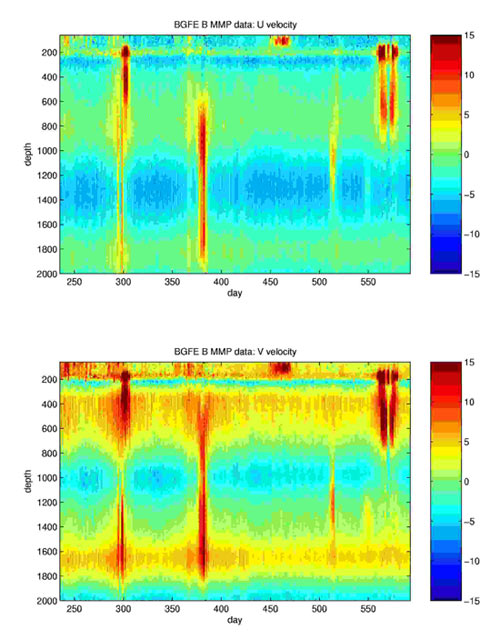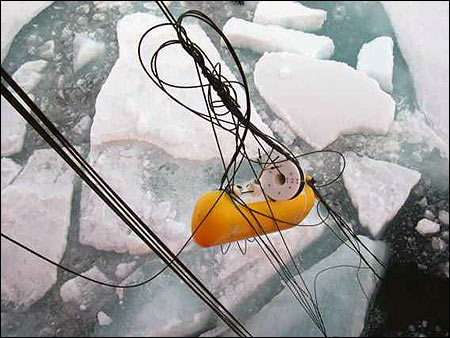Please note: You are viewing
the unstyled version of this website. Either your browser does not support CSS
(cascading style sheets) or it has been disabled. Skip
navigation.
Sarah Zimmermann, IOSAugust 14-21, 2004
August 14-15 The WHOI-B mooring site was covered in 10/10 ice when we arrived. The ship was breaking pieces of ice up into smaller chunks but they were still rather large, under compression and filling in the opening quickly, not allowing us to make a hole large enough to pop the mooring up into. We took a short helicopter flight updrift and found an area full of open pools that would be over the mooring site in the morning. This means we gave up a day from the two-day transit we were going to make between the recovery and deployment, but it certainly made sense knowing that the recovery condition would likely be much better the next day. Sitting on the mooring site for the night gave us a chance to take two CTD casts- one a typical cast and the other fulfilling multiple purposes (stopping the CTD package for bottle closures to determine calibration points in the higher salinity and oxygen gradient water; sampling the bottom water and the Atlantic layer intrusions at higher resolution than in the standard cast; seeing what kind of difference we get in bottle data after waiting ½ min, 2 min, 5 min before closing bottle ). The next day was perfect. Open water areas allowed the ice broken up by the ship to be pushed out of the way. The Captain made a nice ice-free hole, the mooring was released and the top float popped right up in the opening. The set of floats on the end of the mooring were hidden until the last 50m of line was being brought in. They were tucked under a chunk of 2-3m thick ice. We saw the yellow glow through the ice coming from the floats. The bubbler was used to rock the ice and the floats rolled out. It did give us a warning of how something even with that much floatation (~2500#) could get stuck under a floe. The data from the moored profiler is amazing. It profiled every day for the entire deployment. We changed some of our deep rosette depths based on what we saw in the profiler data. Waldek’s LADCP and the moored profiler both have current profiles for the same day- it seems like a cross comparison might be useful? August 16 We spent our turnaround day heading a little farther to the west and then north. The station at 79N 150W was our farthest north, and here we took extra chemistry samples. We tried to make it up to 80N, but as the ice thickened (and the fog lifted giving us a brilliant blue day) we ran out of time. Our last ditch effort was to take a CTD cast at 79N 20’ but then the CTD wire got caught in the shiv on deployment. Doug went ahead with a retermination - but there was not enough time to wait for this lengthy repair process. Instead, Motoyo and Masuo deployed an XCTD and we headed back to the mooring site at 78N for the deployment. August 17 The deployment went well. It’s much easier to deploy than recover! The winds were light, we set up 4 miles or so updrift, floated with the ice until the mooring was assembled, and let go. August 19 Next on the list was to look for thick ice for the ice tethered profiler on our next leg from WHOI-B to WHOI-C mooring sites. We had plans to survey for big thick ice floes via helicopter but the fog was too thick for flying. 7pm on the second day the ship came across a thick piece of multiyear ice. Rick and John flew out to drill test pits. Sure enough it was thick, too thick in some spots. The next morning beginning at 6am, the buoy equipment was set up- within 1/2 mile from the ship but with fog thick enough to often obscure the ship from view. All went smoothly with the WHOI guys setting up the Ice Tethered Profiler and Doug and Andrew setting up the Ice Mass Balance Buoy. The 4m holes took at least as long to drill as the installation of the equipment! Rick has heard from John Toole back at WHOI that the data is being transmitted loud and clear, the ITP has been making its 800m profiles with enough resolution to pick out the Atlantic layer steps. Great news!! Except I sure will miss field work if everything gets replaced with moorings and buoys. Thank goodness for water samples! August 20 The mooring work has been thick and fast--an operation every other day for the last week. We did not have enough time to try for WHOI-C the afternoon after the buoy deployment but we did stop to range on it, followed by a rosette cast farther to the east. The day after (yesterday) we were back on the site. The ship spent 2 hours munching up the ice slightly updrift of the site although there was little drift (0.2 knot). Again the ice was under compression with full cover, this time with more ridging in between the first year and some older floes mixed in. We had fog again and misting/rain and finally the bubbler system was not fully working. We considered waiting a day. Even when the bubbler came back on line, the ice free opening we could make was still ~50m x 50m and with the bubbler shut off to allow the transducer to talk with the release the hole closed up quickly. Before leaving, we surveyed the updrift track, there was a small hole ~4 hours away, a better area of all first year ~10 hours away, but then heavy ice again past that. It was too late in the day to wait for the second patch and it was clear waiting a day would not improve our chances so we decided to at least wait for the first small hole. Sure enough, it gave us the edge we needed. The crunched ice from the morning had melted some, increasing the visibility into the water. The fog had lifted, and there was less compression, especially when we made an ice coral out of the hole. The Captain made an opening just large enough, and because the location of the buoy was so well known, they were able to release the buoy right into the small ice-free hole. I think the Captain is hooked on the adrenaline rush of moorings now. The recovery was a huge tangle although handled safely by those on deck. There were up to 9 strands being recovered at one time! It did make for a quicker recovery, down from 4 hrs to 2.5 hours. Success again, the profiler shows it had been climbing its 2000m segment daily for the past year.
We’ve just finished the last northerly station. Its all southward from here. If we do get our extra days we may swing east to pick up some of the stations we’ve had to drop due to lack of time. Rosettes and nets have been going well. In the thicker ice we have not been able to deploy simultaneously, and even still the net work suffers from catching chunks of ice. Its par for the course though. Today we were fortunate to find an open hole (winter is coming- it had a layer of ~1 cm new ice on the surface) which finally let Amanda take her full three casts without ice. We have the extra time right now since we do not need to be back at the mooring site until the early morning. Its been really good to have equipment working, allowing everyone time to take a look at their data and check the quality. Andrew has been watching over the salinities. He and Bill spent many hours today plotting data to show the autosal drift during the runs. There is always a positive drift with standard water having a higher conductance by the end of the run. They confirmed that reusing the opened standard water later during the run was not appropriate- there seems to a very quick evaporation into the open space. We have also started collecting the deep water as calibration checks. If the deep water value changes too much, then we know its time to restandardize. Oxygens, nutrients and chlorophyll are going well (there is usually enough water for everything). Linda has run all the frozen samples too. Ship life is really nice. They are taking care of us out here. Kathy, the baker, delivered her still-hot donuts on a silver platter to the main lab today. What a dear. No one is losing weight. John Kemp and Blane the bosun are exchanging compliments on each others deck work. The Captain is doing all he can to make things go well. And, we’re still in the midst of the cribbage tournament…
Last updated: October 7, 2019 | |||||||||||||||||
Copyright ©2007 Woods Hole Oceanographic Institution, All Rights Reserved, Privacy Policy. | |||||||||||||||||




